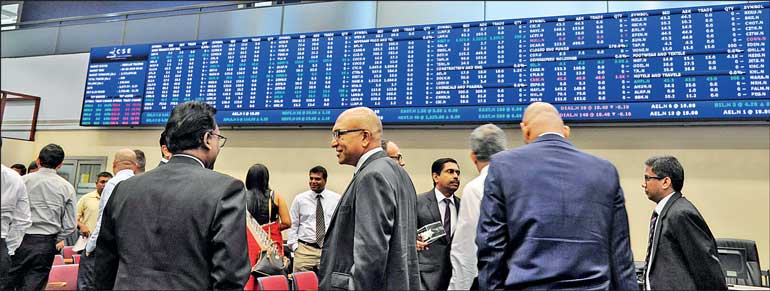Monday Nov 24, 2025
Monday Nov 24, 2025
Friday, 3 March 2023 00:10 - - {{hitsCtrl.values.hits}}

Although the recognition of the offence under the new SEC Act is a welcome move, proving the offence remains challenging
 Market manipulation involves the unwarranted interference in the operation of demand and supply for securities in a stock market.
Market manipulation involves the unwarranted interference in the operation of demand and supply for securities in a stock market.
Interference in the market may be achieved where manipulators disseminate misleading or false information about an issuer or its securities or through artificial transactions intended to convey false information regarding the forces of demand and supply for the market or price of securities.
The offence of market manipulation was introduced into the laws of Sri Lanka for the first time through the Securities and Exchange Commission Rules issued under the Securities and Exchange Commission of Sri Lanka Act No. 36 of 1987 (as amended). Rule 12 of the said rules reads: “No person shall create, cause to be created or do anything that is calculated to create a false or misleading appearance or impression of active trading, or a false or misleading appearance or impression with respect to the market for or the price of any securities listed in a licensed stock exchange”.
Section 128 of the Securities and Exchange Commission of Sri Lanka Act, No. 19 of 2021 (SEC Act) is an almost verbatim repetition of Rule 12 of the SEC Rules issued under the former Act. However, the phrase “calculated to create” under the former Act is replaced with “intended to create” in the new SEC Act. The aforesaid replacement has unequivocally introduced the element of mens rea (the mental element) in proving the offence.
Additionally, no person should shift the market price by the sale or purchase of any security that does not involve the change in the beneficial ownership of those securities, or by means of fictitious transactions.1 Further, ‘Artificial transactions’ have been explained to have the effect of raising, lowering or pegging, fixing, maintaining or stabilising the price or volume of securities of the company for the purpose of inducing other persons to acquire or dispose of the securities of the company or a related company.2
Interestingly, the amendments to the law on market manipulation in Sri Lanka marks the shift in dealing with the offence under criminal to civil proceedings by the Securities and Exchange Commission. On the other hand, criminal proceedings under the new law will be instituted by the Attorney General in the High Court. In the past, the higher burden of proof required in a criminal proceeding, in conjunction with the complexity of the offence, induced regulators to exercise their power of compounding.3, 4 This was also an attempt to circumvent the delays in criminal court proceedings, as illustrated in Magpek Exports Limited v SEC, which took over 20 years to conclude since the initial institution in 1997.5
Thus, the new SEC Act empowers the SEC Commission to institute civil proceedings in the Commercial High Court where the Commission considers it necessary.6The action instituted shall be proved on a balance of probability.7
The new SEC Act has also enabled the SEC to enter into an agreement with the offender, instead of resorting to civil actions in court. The agreement shall collect an amount three times the gain made or the loss avoided by such person (with or without admission of liability). One third of the money inter alia will be used to compensate or restitute the victims of the offender’s action.
Although the recognition of the offence under the new SEC Act is a welcome move, proving the offence remains challenging. Articulating a more general or precise definition of market manipulation is difficult. While some forms of market manipulation such as the spreading of false statements popularly known as “pump and dump” schemes or “thrash and cash” schemes may be comparatively straightforward, many others may be highly complex or sophisticated practices designed to artificially distort the market price of a security.
In some instances, interference with the price forming mechanism has been recognised by academic commentators as acceptable and even desirable. For example, the operation of price stabilisation rules applicable to market makers or even underwriters are regulated and are therefore permissible activities. Another example is where a company decides to purchase its own shares in order to deliberately push the price up. Thus, the offence of market manipulation is obscured where the company genuinely believes that its shares are undervalued and causes the price to move in the right direction.
A core feature of manipulation is to move the price further away from its “correct level”. However, ascertaining this level of a security is gruelling. Academic commentators have suggested that although some aspects of market manipulation should be prohibited (especially where fraud is present) other aspects of market manipulation done to control or minimise price distortion effects should be deregulated.
As such, Section 185 of the SEC Act provides “notwithstanding anything to the contrary in this Act, a market maker licensed as a market intermediary shall not be considered as committing an offence under sections 128 or 129 of the Act when carrying out the functions relating to its licensed activity.”2 (Sections 128 and 129 are the provisions prohibiting false trading and market rigging transactions and acts of market manipulation under the said Act).
The difficulty in ascertaining artificial transactions has caused regulators to rely on an effects-based criteria. In the 1930s, the United States Congress has identified certain types of behaviour to be manipulative. These include;
a) wash trades or sales – transactions not intended to change in beneficial ownership,
b) matched orders – orders for the purchase or sale of a security with the knowledge that an order of substantially the same size, time and price has or will be entered into by the same or different parties,
c) short sales – involves borrowing a security whose price you think is to fall from your brokerage and selling it on the open market,9 and
d) trading in a security for the purpose of inducing the purchase or sale of such security by others.
However, these indicators are not exhaustive and may not be conclusive. Thus, commentators have simplified the offence to three things; (a) interference with the free play of demand and supply; (b) induce people to trade; and (c) force a security price to an artificial level.10
The difficulties in establishing objective criteria for manipulation is a catalyst in the adoption of a subjective test; thereby focusing on the improper intent of the trader.
In light of the challenges associated with the offence of market manipulation, it could be argued that the new SEC Act has made considerable attempts to combat the hurdles faced. The SEC has moved away from the high burden of proof in criminal proceedings, adopted subjective tests, and given meaning to the term ‘artificial transaction’. However, the deeper meanings to the terms interjected in the provisions remain ambiguous and can only be dealt with on a case-by-case basis depending on the facts and circumstances of each case.
Footnotes:
1Securities and Exchange Commission of Sri Lanka Act, No.09 of 2021 S 128 (1), (2).
2ibid S 129.
3Securities and Exchange Commission of Sri Lanka Act No.36 of 1987 S 51A (as amended).
4Compounding is the cessation of a prosecution after an offender pays a sum not exceeding one third of the sum imposable by the Magistrate as a fine to the SEC, which sum is thereafter credited to the compensation fund of the SEC.
5Magpek Exports (Pvt) Ltd v SEC HCMA 217/2007.
6The Commission shall take into consideration the nature and manner of the contravention, the impact of the Commission of the offence had on the market and the extent of the loss caused to any investor.
7Securities and Exchange Commission of Sri Lanka Act, No.09 of 2021 S 152 (2).
8DR Fischel and DJ Ross, ‘Should the Law Prohibit “Manipulation” in Financial Markets?’ [1991] 105 Harvard Law Review 503.
9The intention is to buy the same stock back later for a lower price than you initially sold it for, and pocket the difference after repaying the initial loan. However, in emerging markets outside Sri Lanka this practice is permitted amongst specified persons and are subject to rules.
10DR Fischel and DJ Ross n(8).
(The writer is a Partner of the legal firm Varners and was formerly the Director Legal and Enforcement of the Securities and Exchange Commission of Sri Lanka. The views expressed herein are those of the writer and may not necessarily be the views of the Securities and Exchange Commission of Sri Lanka.)